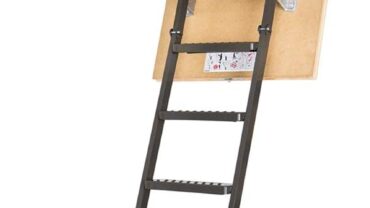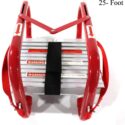How to Use a Ladder on A Sloped Roof?
Ladders are pretty convenient to use when you want to change light bulbs, drill a hole on the wall, hang any art on the wall at height, or whatever you have in the bucket list. The pretty simple ladder can give a pretty wide versatility when doing any kind of stuff. When it comes to working on the roof, you can go with an extension ladder and reach out to any area of the roof. The versatility is pretty striking. Meanwhile, a new person using the ladder have fear about the right method and placing the feet of the ladder to a rigid surface.
When it comes to using a ladder on a sloped surface, the fear factor rises because a little error can make you fall easily. Working on a sloped roof is a common example of this fear. DIY projects for home maintenance require the use of a ladder, and when you want to reach the surface of the attic area, you better choose the right method. Ladders come in several sizes, and it can increase the confusion for amateurs. To avoid any mistake, using all the safety gear and the supervision of any home member seems a practical choice.
Contents
How to Use a Ladder on A Sloped Roof
Still, have some confusion? Let’s learn about the safe method to use a ladder on a sloped roof
#1. Check your Ladder
When working with a stepladder, it would be safe to check if the metal braces are locked property. These are called spreaders, and it should be safely connected. You can apply a little pressure to ensure whether they can take your weight or not. Inspection reduce the risk and ensure you a safe working experience.
#2. Find Even Surface
To place a ladder properly, looking for an even surface is important for safety purposes. As if the ladder is tilted to any of the directions, left or right, then the potential of falling increases. If the surface looks even but the ladder is not straight, clean that particular area and then begin. There are some special techniques to use ladders on uneven surfaces and if you are not used to it, don’t try even if you have lots of curiosity.
#3. Clean Debris and Slippery Stuff
The surface where you will be placing feet of ladder might have some sort of debris or slippery content. By cleaning out the complete surface where the feet of the ladder will be, you eradicate the major risk. During the rainy season, the roof surface gets slippery by a little, so maintain proper clean up before starting.
#4. Know Your Limits
When working with ladders, you should know the limits. Sloped surfaces are hard to deal with a ladder, and going to the top three ladders is risky. It might sound tempting that the top three steps are pretty cool to sit on, but they can easily create more weight in the top area and slip the bottom part. Staying in center of the rung is also necessary.
#5. Align Property
The most important step while setting up a ladder is to alight properly. The ladder should be three to four steps larger than the roof and extended to go out of the top part. When the ladder is few feet higher than it won’t slip and it will create an even balance. Even if it slips, the chances of survival still exist because the top part can stick and protect you.
#6. Keep it away from Electrical Power Lines
Setting a ladder near any electrical power line is dangerous. No one knows that when a ladder might slip, and if you are near to electric wires, the risk is doubled. To avoid getting electrocuted, hire professionals in such works and do not leave the ladder unattended, especially when you have children around.
#7. Tool Belt
Using the right gear to fix a problem can reduce risk and increase your efficiency. Wearing a tool belt instead of keeping your tools at ladder reduce the weight and reduce slipping related issues. A normal tool belt can easily keep all the necessary tools in one place and help you feel safe. Choosing smart and lightweight tool belt will allow you to get more out of the small pocket.
#8. Climbing on Roof
When going above, staying close to the ladder seems safe, but it isn’t. Do not get too close to the ladder; otherwise, it will slip. The risk is weight shift from rung to the feet of the ladder. When you are a bit high from the surface, you are distributing the weight equally on the top and bottom part of the ladder.
Note – Ladders are of many types, and the above-mentioned instructions are mainly for the step ladder and extension ladder. Both are easy to use on a sloped roof, and you have a safe working experience with these two choices. One bonus tip for a first-time user is, do not to climb on the roof.
Conclusion
Ladders are quite simple looking tools, but they are risky at the same time. When working with ladders, you should be sure that you are not afraid of heights. Some people consider DIY projects fun and get to the roof, but going down seems like an issue. The best option in such a situation is to leave the work on professionals and not to take such life risk.



